GREECE
ref. # 021d Greece -the world according to Herodotus 450 bc
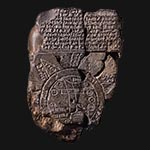 Modern reconstruction of the Oikumene [inhabited world] of the Greek historian Herodotus (active 440-425 B.C.).
"The 'Histories' (from which the content of this map is taken) were occasionally criticized in antiquity, but modern historians and philosophers generally take a positive view. Despite the controversy, Herodotus still serves as the primary and often only, source for events in the Greek world, Persian Empire, and the region generally in the two centuries leading up until his own day. Herodotus, like many ancient historians, preferred an element of show to purely analytic history, aiming to give pleasure with "exciting events, great dramas, bizarre exotica." As such, certain passages have been the subject of controversy and even some doubt, both in antiquity and today" wikipedia
Modern reconstruction of the Oikumene [inhabited world] of the Greek historian Herodotus (active 440-425 B.C.).
"The 'Histories' (from which the content of this map is taken) were occasionally criticized in antiquity, but modern historians and philosophers generally take a positive view. Despite the controversy, Herodotus still serves as the primary and often only, source for events in the Greek world, Persian Empire, and the region generally in the two centuries leading up until his own day. Herodotus, like many ancient historians, preferred an element of show to purely analytic history, aiming to give pleasure with "exciting events, great dramas, bizarre exotica." As such, certain passages have been the subject of controversy and even some doubt, both in antiquity and today" wikipedia©: picture from: www.henry-davis.com
tags: #herodotus
ref. # 022 Greece -Pytheas
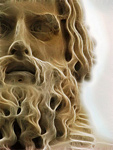 "Pytheas of Massalia (Latin: Massilia - 4th century BC), was a Greek geographer and explorer from the Greek colony of Massalia (modern-day Marseille). He made a voyage of exploration to northwestern Europe in about 325 BC, but his description of it, widely known in Antiquity, has not survived.
"Pytheas of Massalia (Latin: Massilia - 4th century BC), was a Greek geographer and explorer from the Greek colony of Massalia (modern-day Marseille). He made a voyage of exploration to northwestern Europe in about 325 BC, but his description of it, widely known in Antiquity, has not survived.In this voyage he circumnavigated and visited a considerable part of Great Britain. He is the first person on record to describe the Midnight Sun. The theoretical existence of a Frigid Zone, and temperate zones where the nights are very short in summer and the sun does not set at the summer solstice, was already known. Similarly, reports of a country of perpetual snow and darkness (the country of the Hyperboreans) had reached the Mediterranean some centuries before. Pytheas is the first known scientific visitor and reporter of the Arctic, polar ice, and the Germanic tribes. He introduced the idea of distant Thule to the geographic imagination, and his account of the tides is the earliest known to suggest the moon as their cause."
©: text from 'Wikipedia'
See also: Pathfinders, a Global History of Exploration, page 28, ISBN 978-0-393-33091-5 as well as our Pinterest site!
tags: #Pytheas
TIMELINE
022a Greece -Odysseus and the Sirens
"The Odyssey is one of two major ancient Greek epic poems attributed to Homer. It is, in part, a sequel to the Iliad, the other work ascribed to Homer. The poem is fundamental to the modern Western canon, and is the second oldest extant work of Western literature, the Iliad being the oldest. Scholars believe it was composed near the end of the 8th century BC, somewhere in Ionia, the Greek coastal region of Anatolia.""Returning to Circe's island, they were advised by her on the remaining stages of the journey. They skirted the land of the Sirens, who sang an enchanting song that normally caused passing sailors to steer toward the rocks, only to hit them and sink. All of the sailors except for Odysseus, who was tied to the mast as he wanted to hear the song, had their ears plugged up with beeswax. They then passed between the six-headed monster Scylla and the whirlpool Charybdis, Odysseus losing six men to Scylla, and landed on the island of Thrinacia. Zeus caused a storm which prevented them leaving. While Odysseus was away praying, his men ignored the warnings of Tiresias and Circe and hunted down the sacred cattle of the sun god Helios as their food had run short. The Sun God insisted that Zeus punish the men for this sacrilege. They suffered a shipwreck as they were driven towards Charybdis. All but Odysseus were drowned; he clung to a fig tree above Charybdis. Washed ashore on the island of Ogygia, he was compelled to remain there as Calypso's lover until she was ordered by Zeus, via Hermes, to release Odysseus."
TIMELINE
©: 'Odysseus and the Sirens' by , rbert Ja, s DRAPE, (c. 1909), oil on ca, as, 177x213,5 cm. Ferens Art Gallery Public Domain Wikipedia
tags: #Odysseus #Odyssey #Herbert James Draper #Ferens Art Gallery
ref. # 022e Greece -Map of the Ancient Greek World
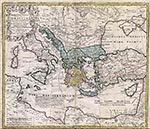 Homann Heirs Map of Ancient Greece the Eastern Mediterranean - Geographicus - Graecia-homannheirs 1741
Homann Heirs Map of Ancient Greece the Eastern Mediterranean - Geographicus - Graecia-homannheirs 1741This is one of the Homann Heirs finest and most appealing maps of the ancient Greek World. Map centers on Greece but includes the entirety of the eastern Mediterranean and North Africa. Also includes the Black Sea as far as the Crimea and the sea of Azov. Extends north as far as Sarmatia and Pannonia. Includes Italy, Sicily, Corsica and Sardinia. Upper left quadrant features a decorative title cartouche adorned with the rectos and versos of 12 ancient Greek coins with explanatory numbered references outside the top border of the map. Show the important Greek provinces and colonies through the Mediterranean, especially in modern day turkey and in the Italian peninsula. Includes nautical military and trade routes. This map was drawn by Joanes Christoph Harenberg for inclusion the 1752 Homann Heirs Maior Atlas Scholasticus ex Triginta Sex Generalibus et Specialibus... Most early Homann atlases were 'made to order' or compiled of individual maps at the request of the buyer. However, this rare atlas, composed of 37 maps and charts, was issued as a 'suggested collection' of essential Homann Heirs maps. A fine copy of an important map. ©: This file was provided to Wikimedia Commons by Geographicus Rare Antique Maps, a specialist dealer in rare maps and other cartography
tags:
,
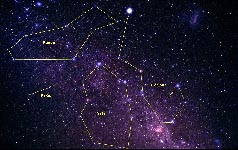 "This large constellation was one of the 48 constellations described by the ancient astronomer PTOLEMY in his 'Almagest'. It is the ship which Argus built for Jason and his crew, the Argonauts, to carry them on their quest for the Golden Fleece. In the 18th century the French astronomer Lacaille divded it into three smaller constellations, Carina the Keel, Puppis the Stern or Poop, and Vela the Sail."
"This large constellation was one of the 48 constellations described by the ancient astronomer PTOLEMY in his 'Almagest'. It is the ship which Argus built for Jason and his crew, the Argonauts, to carry them on their quest for the Golden Fleece. In the 18th century the French astronomer Lacaille divded it into three smaller constellations, Carina the Keel, Puppis the Stern or Poop, and Vela the Sail."
click the small picture and move your mouse over it to see the constellations. ©: Christopher J. Picking www.starrynightphotos.com>/a>
tags: #Argonauts #constellation
ref. # 139b -'the Argonauts'
 "This large constellation was one of the 48 constellations described by the ancient astronomer PTOLEMY in his 'Almagest'. It is the ship which Argus built for Jason and his crew, the Argonauts, to carry them on their quest for the Golden Fleece. In the 18th century the French astronomer Lacaille divded it into three smaller constellations, Carina the Keel, Puppis the Stern or Poop, and Vela the Sail."
"This large constellation was one of the 48 constellations described by the ancient astronomer PTOLEMY in his 'Almagest'. It is the ship which Argus built for Jason and his crew, the Argonauts, to carry them on their quest for the Golden Fleece. In the 18th century the French astronomer Lacaille divded it into three smaller constellations, Carina the Keel, Puppis the Stern or Poop, and Vela the Sail."click the small picture and move your mouse over it to see the constellations. ©: Christopher J. Picking www.starrynightphotos.com>/a>
tags: #Argonauts #constellation
,
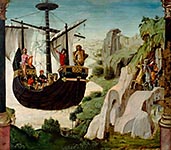 The Argonauts (Ancient Greek:) were a band of heroes in Greek mythology, who in the years before the Trojan War, accompanied Jason to Colchis in his quest to find the Golden Fleece. Their name comes from their ship, the Argo, named after its builder, Argus. "Argonauts" literally means "Argo sailors". They were sometimes called Minyans, after a prehistoric tribe in the area."
The Argonauts (Ancient Greek:) were a band of heroes in Greek mythology, who in the years before the Trojan War, accompanied Jason to Colchis in his quest to find the Golden Fleece. Their name comes from their ship, the Argo, named after its builder, Argus. "Argonauts" literally means "Argo sailors". They were sometimes called Minyans, after a prehistoric tribe in the area."
Artist: Lorenzo COSTA (1460-1535) Title: 'The Argo', Date: 1st third of 16th century, Medium: tempera on panel, Dimensions: 47 x 58 cm (18.5 x 22.8 in), Current location: Museo Civico Padua.
Source/Photographer: The Yorck Project: 10.000 Meisterwerke der Malerei. DVD-ROM, 2002. ISBN 3936122202. Distributed by DIRECTMEDIA Publishing Gmb
©: The work of art depicted in this image and,the reproduction thereof are in the public domain worldwide. The reproduction is part of a collection of reproductions compiled by The Yorck Project. The compilation copyright is held by Zenodot Verlagsgesellschaft mbH and licensed under the GNU Free Documentation License.
tags: #argonaut #greek #mythology
139c -the Argonauts
 The Argonauts (Ancient Greek:) were a band of heroes in Greek mythology, who in the years before the Trojan War, accompanied Jason to Colchis in his quest to find the Golden Fleece. Their name comes from their ship, the Argo, named after its builder, Argus. "Argonauts" literally means "Argo sailors". They were sometimes called Minyans, after a prehistoric tribe in the area."
The Argonauts (Ancient Greek:) were a band of heroes in Greek mythology, who in the years before the Trojan War, accompanied Jason to Colchis in his quest to find the Golden Fleece. Their name comes from their ship, the Argo, named after its builder, Argus. "Argonauts" literally means "Argo sailors". They were sometimes called Minyans, after a prehistoric tribe in the area."Artist: Lorenzo COSTA (1460-1535) Title: 'The Argo', Date: 1st third of 16th century, Medium: tempera on panel, Dimensions: 47 x 58 cm (18.5 x 22.8 in), Current location: Museo Civico Padua.
Source/Photographer: The Yorck Project: 10.000 Meisterwerke der Malerei. DVD-ROM, 2002. ISBN 3936122202. Distributed by DIRECTMEDIA Publishing Gmb
©: The work of art depicted in this image and,the reproduction thereof are in the public domain worldwide. The reproduction is part of a collection of reproductions compiled by The Yorck Project. The compilation copyright is held by Zenodot Verlagsgesellschaft mbH and licensed under the GNU Free Documentation License.
tags: #argonaut #greek #mythology

